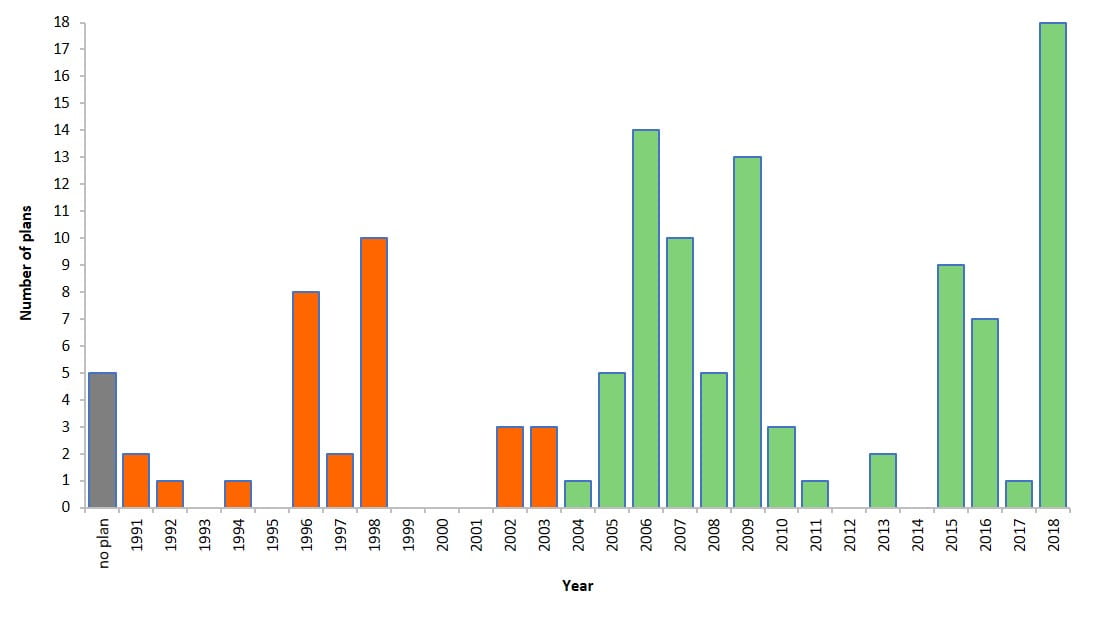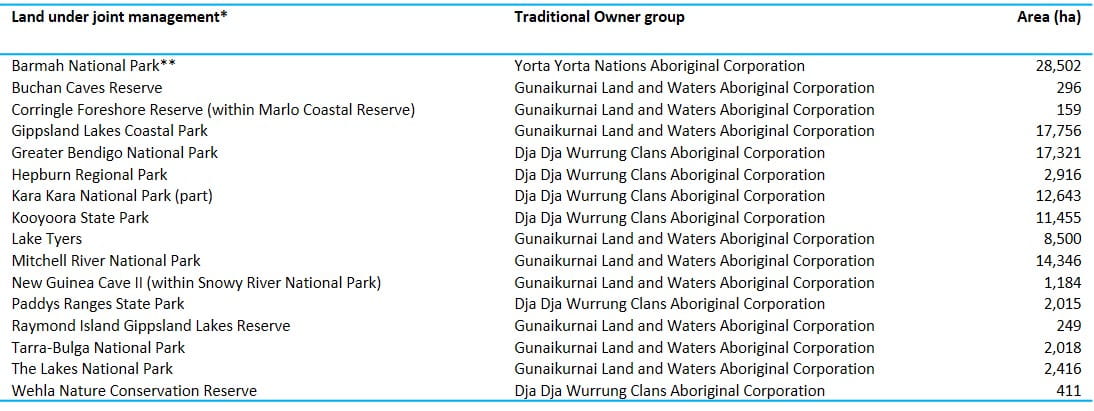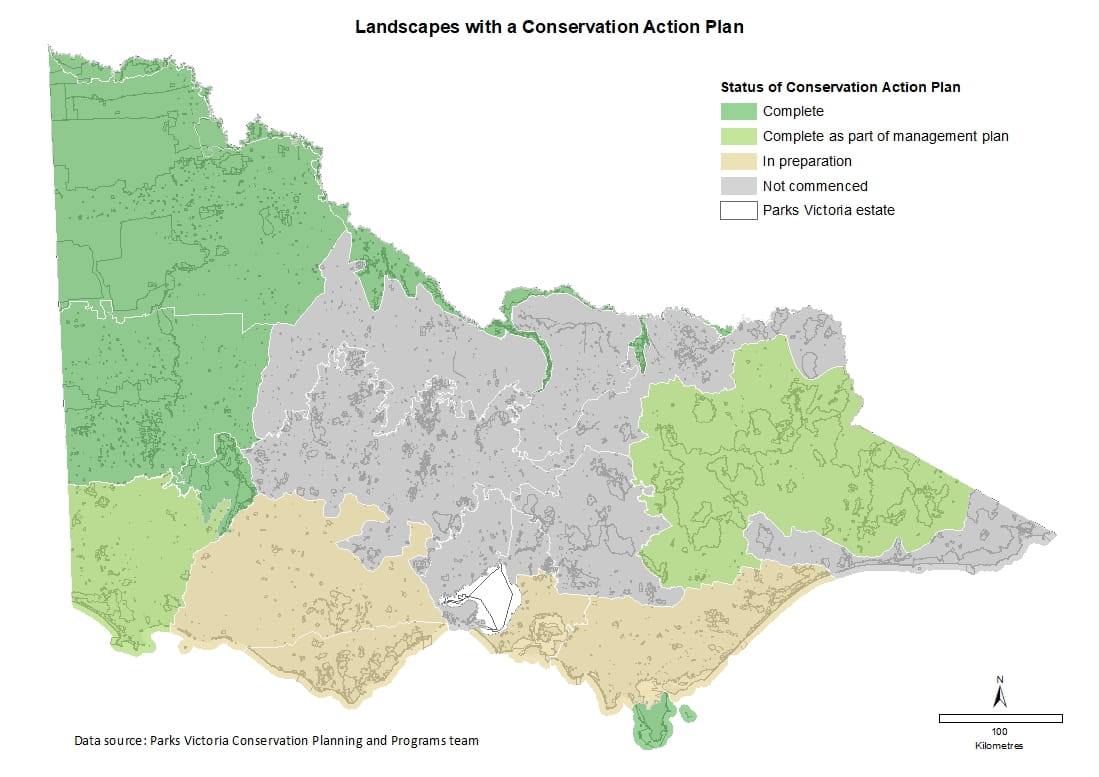Park planning and knowledge
State of the Parks Fourth Edition
Parks Victoria views planning, sharing knowledge and evidence-based learning as essential components in effective parks management.
Park planning and knowledge
Clear plans, and learning from evidence, experience and shared knowledge are crucial to the effective management of parks. As the manager of the state’s parks network, Parks Victoria seeks to build partnerships to gather, analyse and share knowledge to inform its management actions for nature and heritage conservation, and provision of facilities, programs and services for our visitors and community.
Indicators
Park management plans
Park research to improve knowledge and effectiveness
Traditional cultural knowledge
Participation in citizen science and other knowledge partnerships
Park management plans
Park management plans guide the future management of parks over a 15-year timeframe. The plans identify the vision, goals, outcomes, measures and long-term strategies for action. The National Parks Act 1975 requires a plan of management for each national and state park. In addition, Parks Victoria produces Conservation Action Plans, Precinct Master Plans, and a Visitor Experience Framework to guide its planning approach. Management plans adopt a landscape-wide approach to consider things bordering the park that may influence how a park operates.
In areas where Traditional Owner rights and interests have been formally recognised by the State, Parks Victoria-led plans are replaced with Joint Management Plans, which are developed by the relevant Traditional Owner Land Management Board.
National Parks Act parks with a park management plan
- As of 2018, 89 of the 124 National Parks Act parks (72 per cent) had an approved park management plan that was less than 15 years old.
- Nearly one-quarter of parks reserved under the National Parks Act have a management plan that is over 15 years old. With drivers such as climate change, and social and demographic changes, these parks now require more contemporary plans.
- Over the reporting period, seven management plans (including joint management plans) were approved covering 35 National Parks Act parks.

Data source: Parks Victoria State of the Parks assessments
Number of parks covered by Joint Management Plans
- The Victorian Government continues to recognise First Peoples’ rights and interests in the management of Country through Recognition and Settlement Agreements. Traditional Owner Land Management Boards are established to develop joint management plans, which are implemented in partnership between Parks Victoria (or other relevant land managers) and the representative Traditional Owner organisation.
- Joint Management Plans continue to emphasise nature conservation and recreation but bring an increased focus on cultural values, protection of Aboriginal places and the participation of Traditional Owners in management of their traditional Country.
- As of August 2019, 15 of the 16 parks and reserves jointly managed in partnership with Parks Victoria were covered by joint management plans. The remaining park had a draft joint management plan.
- Joint management plans replace any prior park management plans.

*The Gunaikurnai and Victorian Government Joint Management Plan also covers Knob Recreation Reserve which is jointly managed by Gunaikurnai Land and Waters Aboriginal Corporation in partnership with Department of Energy, Environment and Climate Action (DEECA).
**A draft Joint Management Plan for Barmah National Park has been released for public comment
Data source: DEECA
Percentage of landscapes with a Conservation Action Plan
- Conservation Action Plans are created to define and prioritise conservation strategies for specific landscapes, and broadly describe the expected outcomes of those strategies by realistically outlining what can be achieved to address threats that pose the most risk to conservation assets.
- Conservation Action plans are essential in achieving Parks Victoria’s vision of increasing the resilience of natural assets and maintaining ecosystem services across the park network.
- As of 2019, five of the 18 Park Landscapes (22%) had a completed Conservation Action Plan, with a further two (11%) completed as part of the management plan. Four (28%) were in preparation and seven (39%) had not commenced.

Data source: Parks Victoria Conservation Planning and Programs team
Park research to improve knowledge and effectiveness
A strong base of knowledge and evidence is essential to effective park management. Targeted research programs enable park managers to fill key knowledge gaps, address uncertainty and test assumptions. These include both environmental and social research programs.
Number and types of RPP projects completed or commenced
The Parks Victoria Research Partners Program (RPP) continued to deliver collaborative research with universities and other research institutions during the reporting period. Since 2013, more than 60 new research projects were initiated, and many other multi-year projects continued to address critical knowledge gaps and ensure management decisions and actions were supported by high-quality data and science. Projects supported through the Research Partners Program included:
- development of a rapid park health check tool as an early warning for detecting symptoms of degradation in terrestrial parks
- using different technologies (e.g. sonar, remote sensing, thermal imaging) to innovatively monitor and manage parks
- improving how the impacts of fire on biodiversity are measured and considered in managing fragmented landscapes
- development of decision tools to predict how different management actions will affect the persistence of coastal ecosystems and their capacity to sequester carbon
- restoration techniques for degraded habitats
- assessment of risk and control strategies for emerging environmental weeds
- managing the impacts of overabundant native species
- blue-carbon valuation and mapping
- marine pest investigations (removal strategies, prioritisation and biocontrol)
- hydroacoustic and habitat mapping of marine protected areas
Number and types of scientific research permits in parks
In 2017, Parks Victoria introduced ParkConnect, an interactive system for staff and researchers to manage permit applications, request and approve access to parks for research activities, and upload research findings. Based on an analysis of research permits managed in 2017-18, research activity in parks included the following:
- A total of 763 research permits were managed, including the issue of 382 new permits.
- Permits were held by 345 different universities, other research institutions and individuals; universities/colleges (including collaborations) accounted for 23% of these.
- Permits enabled research to be carried out in more than 30 parks (a permit may cover more than one park) or in all parks if required (24 permits).
- More than 90% of the permits were for terrestrial landscapes. Alpine National Park managed the greatest number of permits (260), followed by Great Otway National Park (166) and Gippsland Lakes Coastal Park (134).
- More than two-thirds of permits were predominantly about fauna, with 31% predominantly about flora.
Traditional cultural knowledge
With the vast responsibility of managing over four million hectares of Victoria’s most intact landscapes, Parks Victoria recognises the importance and value of collaborating with Traditional Owners to manage parks in a culturally sensitive and ecologically sympathetic way.
The authority and cultural responsibilities of Traditional Owners to care for Country are being increasingly recognised through Joint Management Plans, co-management agreements and other partnerships.
Cultural knowledge has been an essential component of new park planning approaches. Examples include the development of the Lake Boort Management Plan in collaboration with Dja Dja Wurrung Traditional Owners and engaging and collaborating with Eastern Maar Traditional Owners to inform and co-design visitor infrastructure that respects and celebrates Aboriginal culture as part of implementation of the Shipwreck Coast Master Plan.
Parks Victoria’s Managing Country Together framework is strengthening the organisation’s capacity to effectively manage Victoria’s cultural landscapes in partnership with Traditional Owners. The framework provides both practical and symbolic recognition of Traditional Owner rights, underpins enduring partnerships with Traditional Owners, and strengthens sector capacity in management of joint protected areas and Aboriginal cultural heritage.
Participation in citizen science and other knowledge partnerships
Citizen scientists and community volunteers play a valuable role in gathering information to improve baseline knowledge of park values. Their involvement in this process of understanding, as well as partnerships to improve alignment of research with park management priorities, have dramatically increased since 2007.
During the reporting period Parks Victoria expanded its role in citizen science initiatives to connect people with nature, including:
- developed a new app for the Sea Search program in partnership with CSIRO
- facilitated citizen science surveys monitoring some of Victoria’s most threatened ecosystems and animal species, including over 400 km of spotlight transects in native grasslands at Terrick Terrick National Park and Bael Bael Nature Conservation Reserve.
- provided ongoing support to the Victorian Mallee Fowl Recovery Group, one of the Victoria’s most extensive and long-running citizen science programs
- partnered with Bush Blitz to support expeditions within Croajingolong National Park and on Gabo Island, as well as adjoining seas.
- supported the successful release and monitoring of captive-bred critically endangered Regent Honeyeaters into Chiltern-Mt Pilot National Park
- continued to partner with Conservation Volunteers Australia (CVA) to deliver specialised ‘voluntourism’ products for Naturewise Eco Escapes.
- formed partnerships with specialist citizen science groups including the Field Naturalists Club of Victoria to deliver focused fauna survey programs and publish results.
As technology continues to rapidly develop, there are increasing opportunities to establish and maintain knowledge partnerships with citizen scientists and other organisations to build and share knowledge and help evaluate the effectiveness of park management programs.
Go to previous section of State of the Parks Fourth Edition: Fire and emergency planning, prevention, response and recovery

